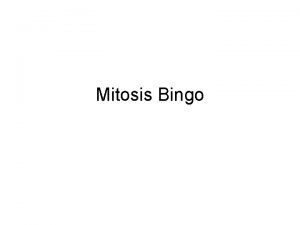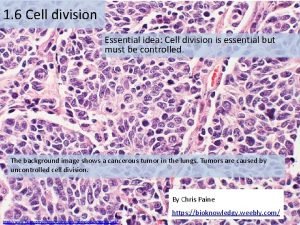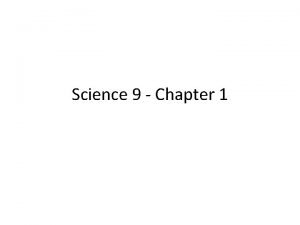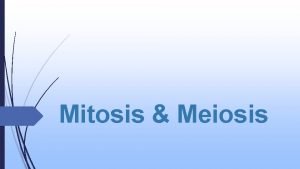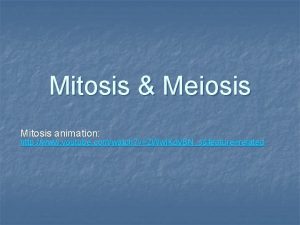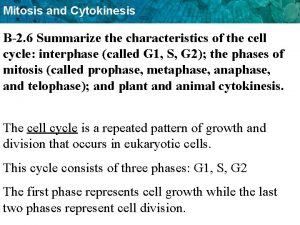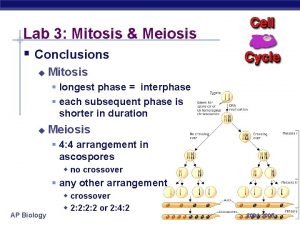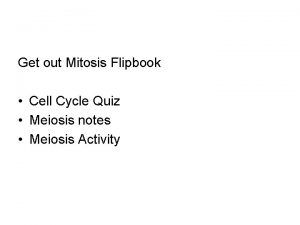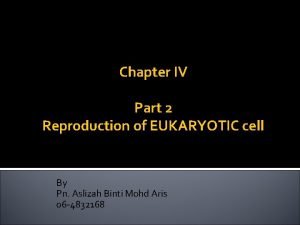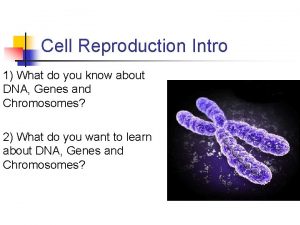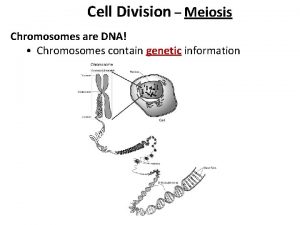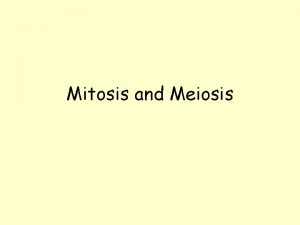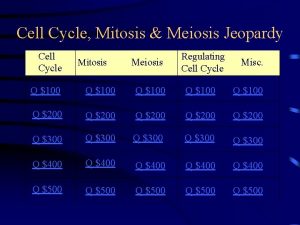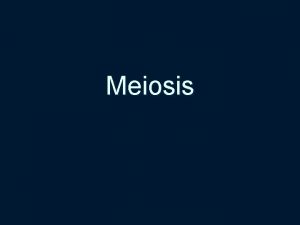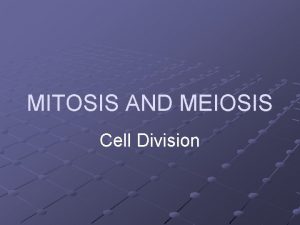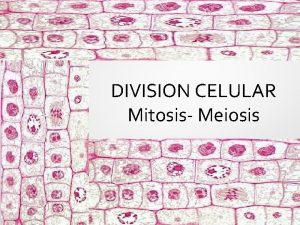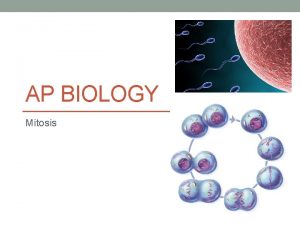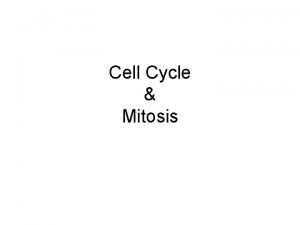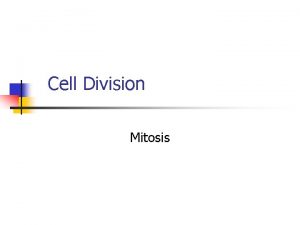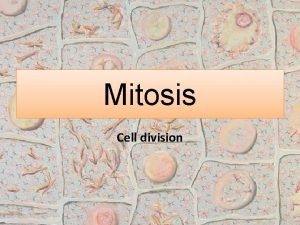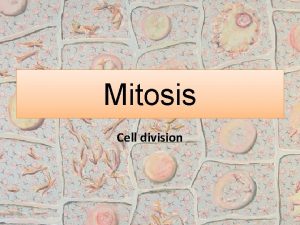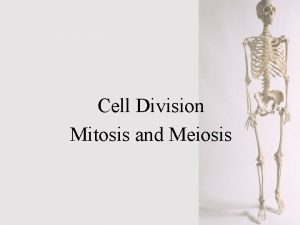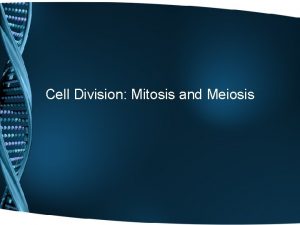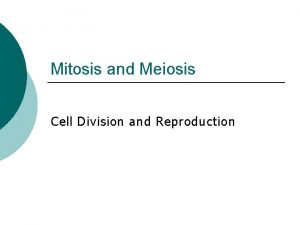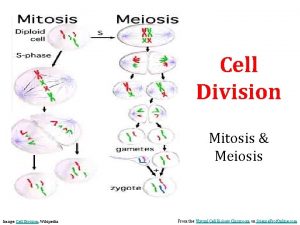Cell Cycle Mitosis and Meiosis Cell Division and





















- Slides: 21

Cell Cycle, Mitosis, and Meiosis

Cell Division and Death • Are required for normal growth and development. • Mitosis produces new cells – Mitosis occurs in somatic cells (all cells but egg and sperm) • Apoptosis is cell death that is part of normal development • Necrosis is cell death in response to injury

The Cell Cycle The sequence of events associated with cell division • S phase: DNA synthesis • G phase: gap for growth • M phase: mitosis (nuclear division) • Cell division or cytokinesis is part of G 1 Figure 2. 15

Stages of the Cell Cycle • Interphase – Prepares for cell division – Replicates DNA and subcellular structures – Composed of G 1, S, and G 2 • Mitosis division of the nucleus • Cytokinesis division of the cytoplasm

Replication of Chromosomes • Process of duplicating chromosomes during S phase • Occurs prior to division • Produces sister chromatids held together at centromere

Mitosis • Produces two identical daughter cells • Chromosomes align • Sister chromatids separate and move to opposite poles. • Nuclear membranes form around each new nucleus • Division of cytoplasm or cytokinesis occurs.

Overview of Mitosis • Continuous process divided into – Prophase – Metaphase – Anaphase – Telophase

Mitosis in a Human Cell Figure 2. 17

Prophase • Replicated chromosomes condense • Microtubules organize into a spindle • Nuclear membrane breaks down Figure 2. 17

Metaphase • Chromosomes line up on the metaphase plate • Spindle microtubules are attached to centromeres of chromosomes Figure 2. 17

Anaphase • Centromeres separate • Chromosomes move to opposite ends of the cell Figure 2. 17

Telophase • Chromosomes uncoil • Nuclear membranes form • Spindle disappears Figure 2. 17

Cytokinesis • Cytoplasmic division • occurs after nuclear division is complete. • Two cells are formed.

Gametes • Form from cell division of germ line cells • Meiosis is cell division to produce gametes • Meiosis has two divisions of the nucleus (Meiosis I and Meiosis II) and produces cells with half the number of chromosomes (haploid)

Homologous Chromosomes • Carry the same genes • Pair during Meiosis I • Separate in the formation of gametes • One copy of each pair is from the mother and one is from the father. Figure 1. 3

Meiosis I : homologous chromosomes separate Spindle fibers Nucleus Prophase I (early) (diploid) Figure 3. 4 Prophase I (late) (diploid) Metaphase I (diploid) Nuclear envelope Anaphase I (diploid) Telophase I (diploid)

Meiosis II : sister chromatids separate Prophase II (haploid) Figure 3. 4 Metaphase II (haploid) Anaphase II (haploid) Telophase II (haploid) Four nonidentical haploid daughter cells

Results of Meiosis Gametes • Four haploid cells • Contain one copy of each chromosome and one allele of each gene • Each cell is unique Figure 3. 4

Recombination (crossing over) • Occurs in prophase of meiosis I A A B B C • Homologous chromosomes exchange genes F • Generates diversity b C D D E E F Figure 3. 5 a a e f c b c d d e f

Recombination (crossing over) a b c A B • Exchange between homologs • Occurs in prophase I a B A b C C c D D E F d E F e f Figure 3. 5 Letters denote genes and case denotes alleles d e f

Recombination (crossing over) a A B b C • Creates chromosomes with new combinations of alleles for genes A to F D E F A a B c b c d d C D E F Figure 3. 5 e f
 Mitosis meiosis
Mitosis meiosis Mitosis
Mitosis Can you fill in the meiosis concept map?
Can you fill in the meiosis concept map? Cell cycle and cell division
Cell cycle and cell division Cell cycle and cell division
Cell cycle and cell division Steps of cell cycle
Steps of cell cycle Mitosis bingo
Mitosis bingo Mitosis and cell cycle terminology
Mitosis and cell cycle terminology Mitosis vs meiosis
Mitosis vs meiosis Characteristics of mitosis and meiosis
Characteristics of mitosis and meiosis Whats the difference between mitosis and meiosis
Whats the difference between mitosis and meiosis Kesler science mitosis and meiosis answer key
Kesler science mitosis and meiosis answer key Gametes vs somatic cells
Gametes vs somatic cells Mitosis and meiosis youtube
Mitosis and meiosis youtube Mitosis purpose
Mitosis purpose Diploid
Diploid Respirometer
Respirometer Mitosis and meiosis venn diagram
Mitosis and meiosis venn diagram Asexual and sexual reproduction venn diagram
Asexual and sexual reproduction venn diagram Chromosome sets (=n) in mitosis and meiosis
Chromosome sets (=n) in mitosis and meiosis Characteristics of mitosis and meiosis
Characteristics of mitosis and meiosis Number of chromosomes in meiosis and mitosis
Number of chromosomes in meiosis and mitosis






